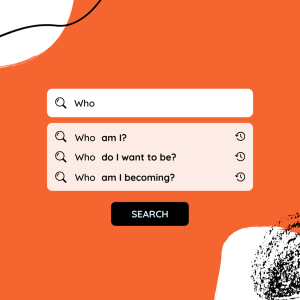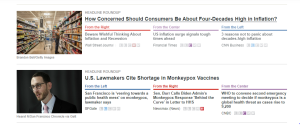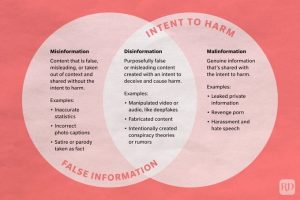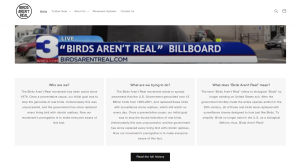Chapter 10: Information Literacy
Guiding Questions
- How do you find information that is both credible and trustworthy?
- What responsibility do we all have to make sure that the information we use and share is accurate?
- Why do people believe information that has been proven not to be accurate?
- How do our own biases impact how we perceive credibility?

By this point in the semester, it is likely clear that you are expected to absorb large quantities of information—but you are also expected to be able to filter that information and judge its quality. When we talk about information literacy, we are describing the process of finding and evaluating your sources. This includes your sources for research papers and school assignments, but also for professional guidance, news, purchasing, and numerous other activities.
Information literacy involves taking responsibility for finding, understanding, and spreading accurate information. Sometimes people assume that information literacy automatically happens with intelligence, but simply being smart does not actually prevent people from being fooled by bad information. As you progress in your major, you will build a strong knowledge base in your field—but a college education is also about being able to determine trustworthy sources of information in fields that you do not have expertise in.
So how do we become information literate?
The basic way that we conduct research in college is collecting information from relevant experts. In some courses, you will also collect and analyze data directly. However, we also need to be able to examine the research that other people have conducted, since we cannot always do experimental research ourselves. For example, if we wanted to know which car is the safest, we cannot crash one of every model on the lot before we make our decision. We also cannot trust that the dealer or the manufacturer will tell us which car is the safest. Instead, we seek out an expert authority who crash-tests all the cars and provides us the relevant information.
Becoming information literate involves two general skills:
- Finding relevant experts: Since we need to rely on the research done by other people, we need to know where to look for experts and how to recognize them when we find them.
- Analyzing competing claims: Sometimes experts might disagree, or it might be difficult to determine whose expertise is more relevant in a situation, so we need to be able to look carefully at the experts and their information.
As one becomes more information literate, one of the frustrating things is that some questions never seem to be completely resolved. People like simple answers and satisfying narratives, but science and data in the real world are messy and complex. People sometimes give up on searching for the truth out of frustration and fall back on statements like “I’m entitled to my opinion” or “there are arguments on both sides.” This is understandable, but as educated people, we have a duty to do better. When gathering data for your classes, understand that you may be expected to make an argument based on incomplete data or on a question that people have not yet reached consensus on. Making those arguments involves taking risks, but not just guessing. On a wide variety of topics where the right answer is not yet known, many of the wrong answers have been eliminated.
Optional Activity #1:What do you notice about these headlines from Allsides.com? How do headlines about the same story differ in the framing or the wording?
|
Examining New Information
- Is it from a credible source?
- Is it relevant to the question at hand?
- Is there more recent information from a credible source that contradicts it?
- Is it accurate, based on previously identified experts?
- What is the purpose of this information?
- Does it cite credible sources?
A credible source is one that has an established track-record of accuracy, fact-checking, and providing reliable information. A good source for examining the credibility of news sources is the Media Bias Chart from Ad Fontes Media. This chart provides clear analysis of major news sources for the reliability of their information and the presence of biased analysis. Other ways to examine the credibility of a source of information involve just looking up the source—for example, if you see information coming from The Onion or another parody news site, a quick web search will tell you that they write satire and you will need to find another source.
Relevant Sources
Just because someone possesses one kind of expertise, does not mean that they have the same kind of authority when talking about other topics. Likewise, even if something is true, it might not be relevant to the case at hand. A simple example of relevance is when you search for directions and the app attempts to give you driving directions when you are walking there—it is not wrong, but you do not have to abide by one-way streets when you are on foot, so that information is not relevant.
Recent Sources
New information comes out at a rapid pace and information can become outdated and misleading quickly. A product review of a makeup palette that says that the color selection is bland and the quality is low might be credible and relevant—but about last year’s product, when those issues have been addressed in the new release. If you are working on a political campaign, you know that you cannot rely on the surveys from the last election. Make sure that you pay attention to the date on a source and double-check if new information has been released.
Accurate Sources
Sometimes new information comes from a source that does not have a track-record at all. In those cases, it is useful to compare that source to more established ones and see if it lines up. For example, if someone says: “don’t worry, there won’t be a tornado, we can’t get tornados here.” I cannot prove anything about the claim “there won’t be a tornado,” but I can check out their claim that “we can’t get tornados here” and find out that Montgomery county has had tornados before. That would suggest that I should not rely on their information.
Check the Purpose of the Information
Sometimes we have two expert sources providing relevant, current information about a topic that seem to disagree in a way that we cannot immediately resolve. On those occasions, it is often helpful to compare the apparent purpose of each source or their motives for providing the information. For example, during the middle of the 20th century, the vast majority of medical researchers agreed that smoking tobacco caused cancer—however, there were some medical researchers that disagreed. These researchers possessed appropriate credentials in their field but came to opposite conclusions. The researchers who claimed that tobacco did not cause cancer were funded by tobacco companies, which means that they had a clear interest in supporting the belief that tobacco does not cause cancer. These sources become less trustworthy because they are committed to their financial or political interests more than they are committed to providing accurate, unbiased data.
Finding Reliable Sources
The best sources are written by experts and “peer-reviewed” (this means that other experts have examined those sources as well and agreed that they are accurate). These sources are typically found by searching the library databases. The advantage of these sources is that you usually do not need to go through the steps to determine their accuracy and validity, the disadvantage is that they can be difficult for non-experts to read.
There are also sources written by experts for a wider audience. This would include documentaries, some non-fiction books, etc. For these sources, you need to verify their expertise, trustworthiness, accuracy, and purpose, but the people who create them often make that information very easy to find.
For current events, news sources from major reliable companies can also be seen as expert sources for a wider audience. These companies (in particular the Associated Press and Reuters, who are at the top of Vanessa Otero’s media bias chart) have built a reputation for accuracy and being free of bias. This does not mean that news sources from the lower tiers are wrong, but even a few errors or occasions of unfair bias undermine our ability to trust their information. For example, when Fox News claimed that Barack Obama was not born in the United States or when NBC Anchor Brian Williams claimed that his helicopter had taken fire during his reporting on the Iraq War, each of those news organizations lost credibility.
Common Misconceptions about Sources
- “If a source is not credible, that means that the information in it is wrong.” Many sources contain accurate information and yet still are not credible. In fact, few sources contain primarily inaccurate information. The difference is that a credible source should contain only reliable information, whereas a source that is not credible will mix opinions or inaccurate information in with those facts.
- “You can tell if a web source is credible based on its domain.” Some domain types are more credible than others, for example a .edu source is generally more credible than a .com source. However, domains vary greatly and not everything published on websites run by universities, government, or organizations is reliable. For example, a .org site might appear to be more credible than a .com, but a .org site is not required to tell the truth or to present information fairly—it might have an agenda.
- “Professors hate Wikipedia and Google.” While most professors will not allow students to use Wikipedia as a source and encourage students to use databases for research, this is not because they have anything against the encyclopedia or the web company. Encyclopedias (like Wikipedia) are known for having fairly reliable information about general knowledge topics, but most courses are asking you to go deeper and learn how people do research in the field (looking at professional journals, primary sources, etc.) and that kind of information is not usually available through Wikipedia or from general web searches.
- “A source is only ‘credible’ if you agree with it.” Sometimes people think that saying that a source is not “credible” is like calling someone a liar or that it is part of a professor’s political agenda, but professors recognize that credible sources can and do disagree. Sometimes there are no credible sources on one side of an argument (for example, when people claim that the Earth is flat or that the Holocaust did not occur), but more often, there are a credible sources on both sides of an argument even if experts disagree on how to interpret the information or what should be done about it.
Two Forms of Information Illiteracy
Gullibility
Being gullible involves believing whatever you are told, regardless of how unreasonable it is. By the time we are in college, most of us are not especially gullible in our everyday lives. We know that we should be skeptical of a commercial that says a new product is “revolutionary” or “will change your life.” However, many people remain gullible when it comes to examining new information on difficult topics. The most common reasons that people continue to be gullible involve three general reasons.
- Confirmation Bias: When we already believe something, we are more likely to find sources that agree with us to be credible, even when those sources are not trustworthy. This is not always a conscious process and to avoid confirmation bias, we need to make sure that we carefully examine the sources that we use to support our own claims to make sure that they are accurate.
- Misplaced Authority: When people are peddling falsehoods, it is easy to find plenty of “authorities” to back up their claims, but often these people possess no relevant experience, knowledge, or credentials that would make them an expert on this topic. For example, the anti-vaccination movement has frequently found celebrities that support their position—but these are actors or politicians without medical or scientific training. Misplaced authority often relies on sheer fame or the use of irrelevant credentials to bolster their claims.
- Peer Pressure: When the term peer pressure is used, many of us have flashbacks to warnings in junior high or grade school about how our peers will pressure us into making bad decisions—often as part of a warning against drugs or alcohol. Long after people leave high school though, peer pressure can lead to bad decision making. Widely held beliefs are difficult to abandon, even when they are false. People can be less likely to see the flaws of a line of reasoning when everyone else appears to accept it. The ad populum logical fallacy (sometimes called the “everybody does it” or “bandwagon” fallacy) discussed in Chapter 9 is related to peer pressure.
Irrational Skepticism
Skepticism is a valuable and intelligent approach to new information. However, sometimes when people say they are “skeptics” about something, they mean that they reject new information about the topic, no matter how credible the source is. Being unwilling to accept facts is not real skepticism. This habit of mind could be called “irrational skepticism” in that it rejects the central idea of rational skepticism, which is that we should base our ideas on evidence.
- (Dis) Confirmation Bias: Since people do not like being proven wrong, the flip side of confirmation bias is that we are typically unreasonably harsh when examining sources that challenge something that we believe to be true. Since we are likely to reject the conclusion of those sources, we often find it easy to reject the whole source even if it is credible and thoroughly researched.
- Dunning-Kruger Effect: The short explanation of this effect is that people who are not skilled at something cannot really imagine the difference between their level of skill and someone with a higher skill level. One way to think about this is that a complete amateur might think that they could score a point on Serena Williams or block a shot from LeBron James, but a top level amateur knows that they might as well be standing still if they stepped onto either one of those courts. The Dunning-Kruger effect is even more difficult for people to understand when it comes to knowledge or research-based skills, since they may believe that they have done “a lot of research” to back up their opinions, without understanding what research in that field looks like. The Dunning-Kruger effect can often cause people to ignore relevant experts—if they disagree with those experts. David Dunning (one of the two researchers who lends his name to the effect), also describes this as “meta-ignorance” meaning ignorance about ignorance. One of the best ways to combat this is to approach new information humbly and assume that people with relevant expertise in a field may be correct—even their claims initially seem unlikely.
Optional Activity #3In groups of three, research and come up with agreed definitions for misinformation, disinformation, and malinformation .
|
How to Identify Unreliable Sources
While all unreliable sources are different, many of them share some characteristics.
- They do not cite their sources. When an author uses claims like “many people are saying” or gives statistics, but does not say where those statistics come from, it is often a sign that they do not have evidence to support their claims.
- They claim to rely on “common sense” or things “everyone knows” when they are arguing against science or data. This is common in social media posts, like those in the anti-vaccine movement that claim vaccines are harmful because of their ingredients.
- The source is not associated with experts or a credible organization. Anonymous authors and knock-off websites commonly produce low-quality or “clickbait” webpages. Some of these are intended to deceive and spread misinformation, others are just designed to funnel traffic to their advertising partners, but in both cases, they are not credible sources.
- The author’s expertise is irrelevant or not verifiable. If someone is discussing medical information and referring to themselves as “Dr.” but they have a PhD in literature or mathematics, they are misrepresenting themselves. Likewise, many people claim that they “have done a lot of research” on topics but they cannot show a degree or a list of publications that would support that claim.
- Unreliable sources are not necessarily lying; often the authors of those sources believe what they are saying. It is seldom worth your time to argue with them, instead, you can just move on to finding legitimate information for your project or for your own research. If you are stuck about how to find information on a topic while you are here at AUM, ask a librarian!
Optional Activity #3 Birds Aren’t RealTake a look at the website for the “Birds Aren’t Real” Movement. Using what you have read about finding credible sources, what do you notice? What questions come up as you read about the movement?
|
Using the Library
When people think of librarians, they often think of someone who can help you check out books or who shushes people who are too loud, but university librarians are experts in research. They know how to quickly find the best sources in the library and online.
Librarians can help you with research at various steps in a project, ranging from answering all kinds of questions and even helping you find the sources required for projects. If you consult with a librarian, the research part of a research paper can be a lot easier.
You can search the library databases for information. As we saw earlier in the chapter, sources from the databases are generally considered credible automatically—which can save you some time. Sometimes students are intimidated by using the library databases because they seem harder to use than a standard search engine, however, librarians can guide you through them and the Quick Search function works much like a standard search engine. The more advanced features (like searching a specific database) can help you narrow down searches so that you do not have to look through dozens or hundreds to find the most relevant ones.
Warhawk Wisdom
Being able to find, understand, and evaluate information requires us to be curious, humble, and honest as we work through our own biases to determine the credibility of that information. This is not always easy, but when we practice curiosity we open ourselves up to examine information and ideas more freely. This is often a humbling pursuit as you may find that new, credible information contradicts something you believe to be true. It is important to allow yourself to grow as you learn and to do so without judgment or shame.
Journal Prompts:
- Who are you now?

a) What types of sources do you use for information?
b) How do you determine if a source is credible?
c) Where do you read/watch news stories?
d) Have you ever shared or been fooled by a fake news story or headline?
e) What is something you changed your mind about after learning more from experts or other credible sources?
2. Who would you like to be?
a) How would you handle a conversation with someone using sources that were not credible?
b) How open are you to changing an opinion if presented with information from credible sources that contradict your opinion?
3. Who are you becoming?
a) Where do you begin looking for information? What is your research process?
b) What specific strategy will you use to resist disinformation, misinformation, and/or malinformation?



